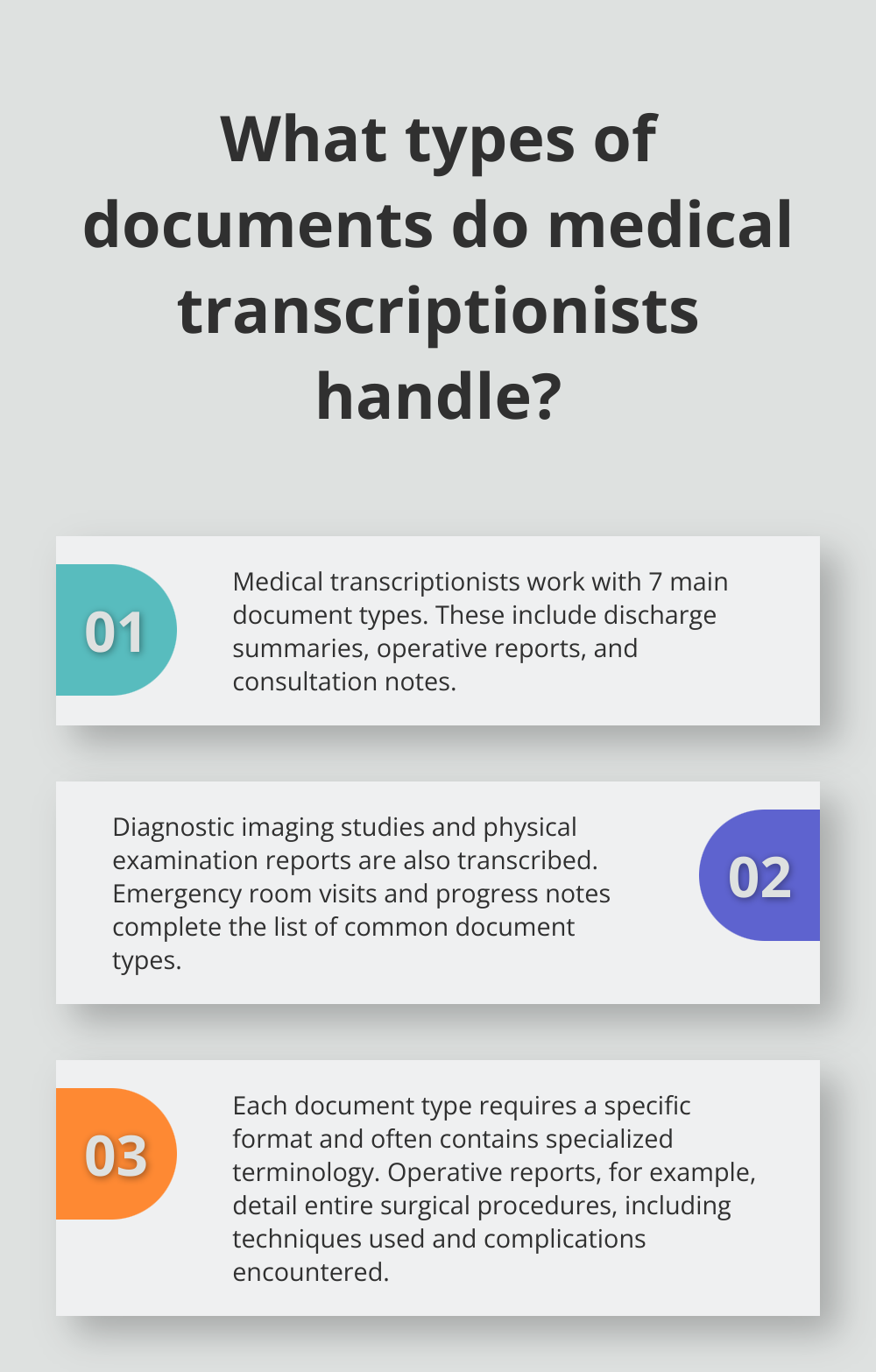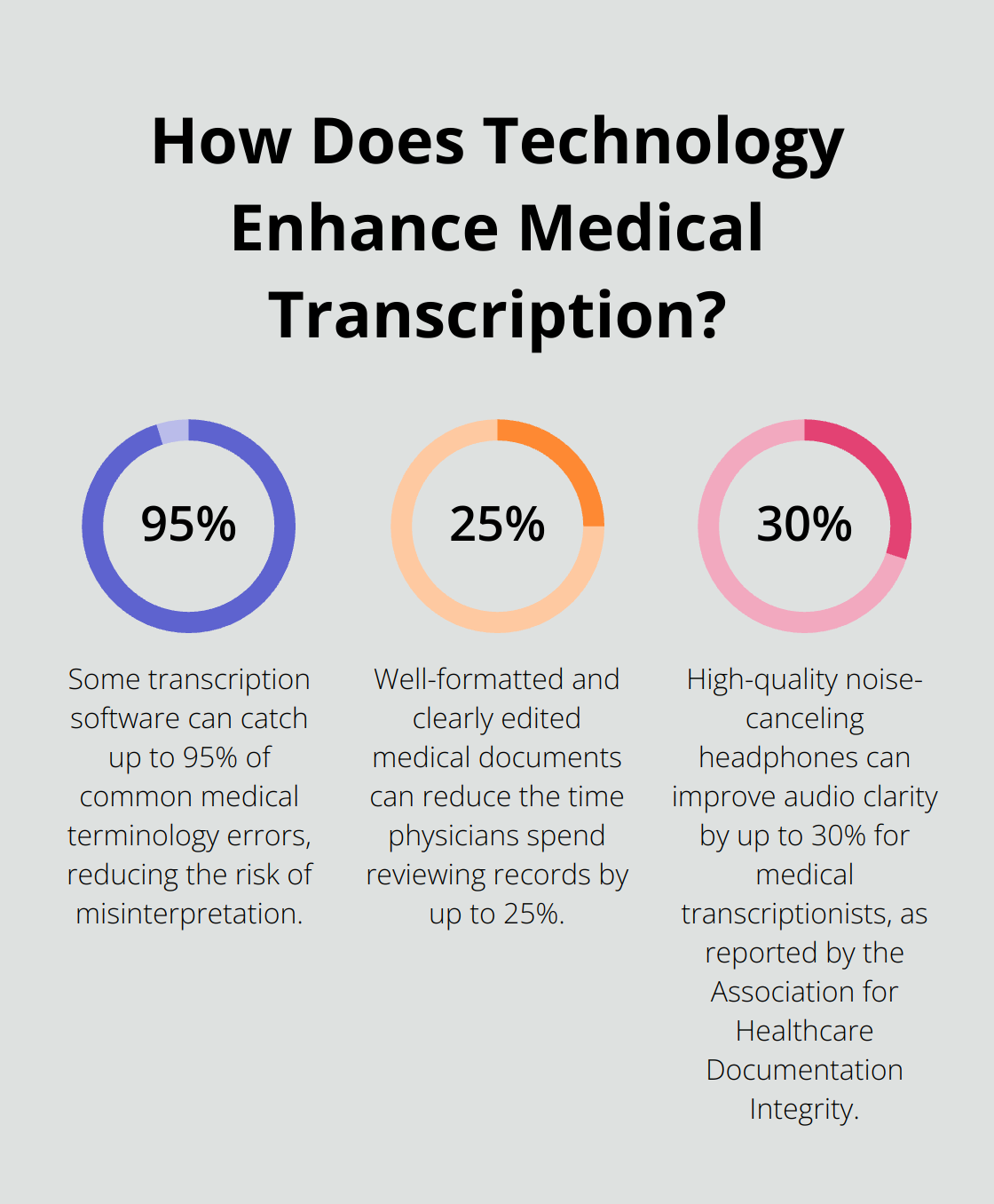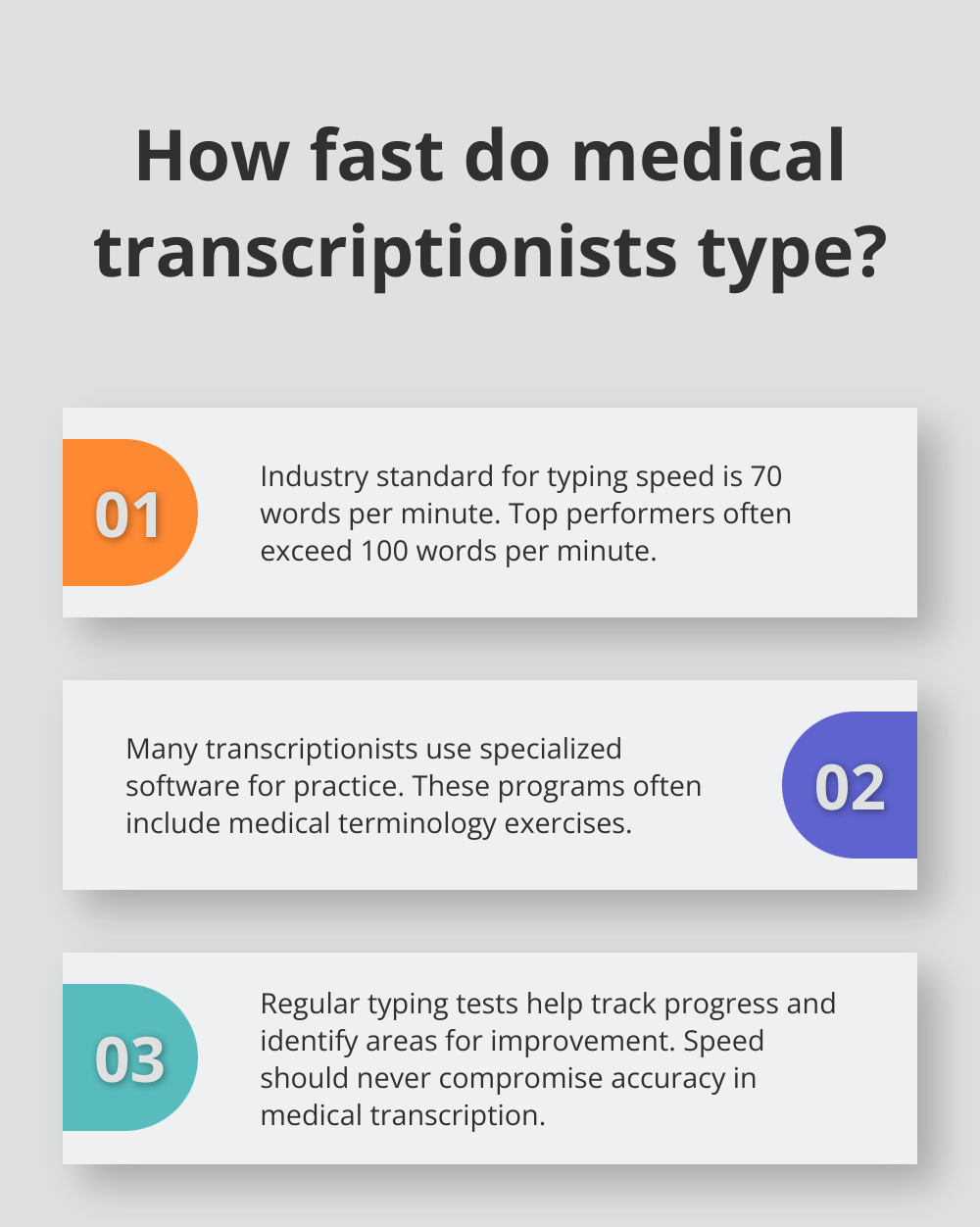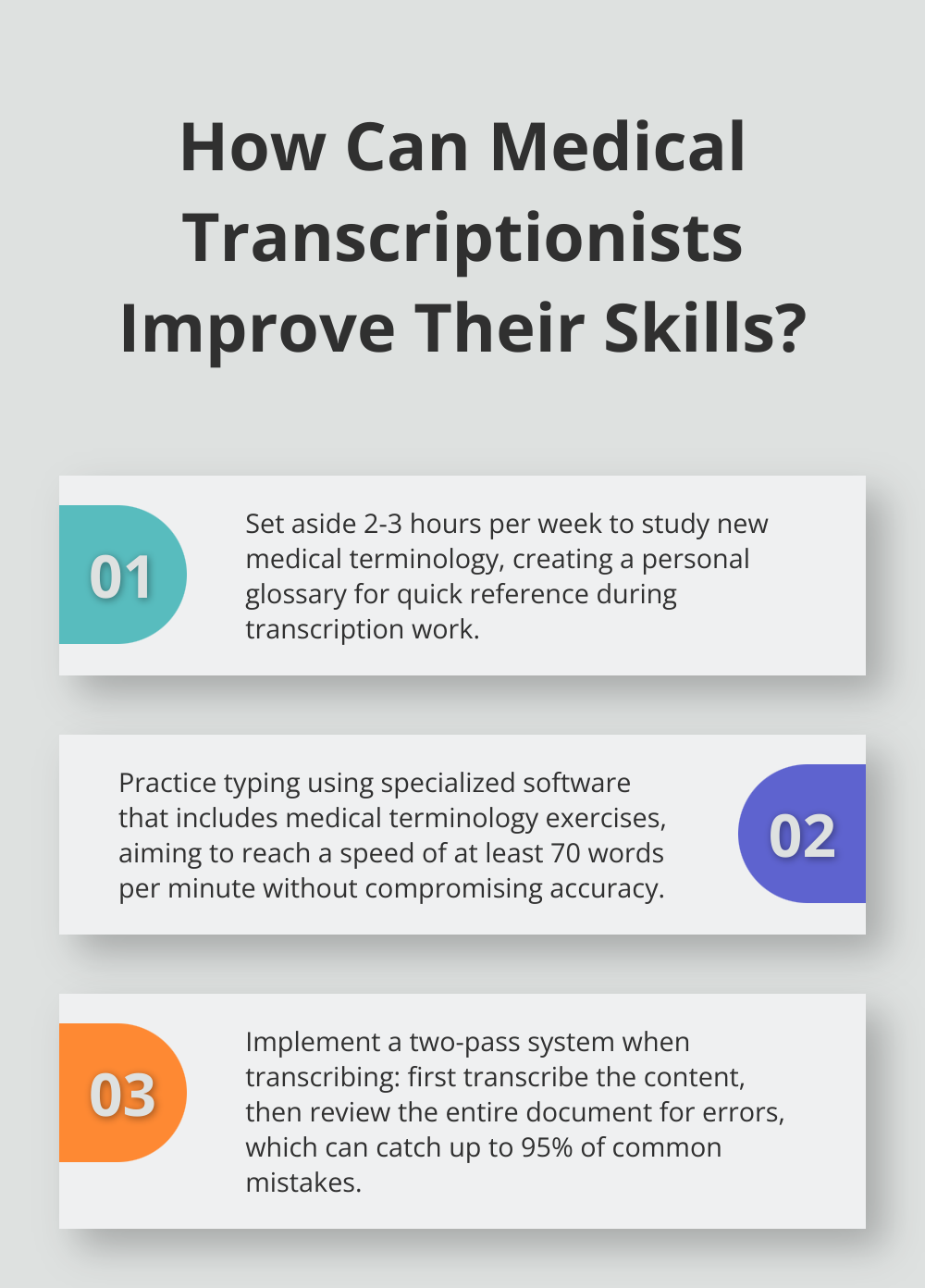Medical transcription is a vital component of healthcare documentation, ensuring accurate and timely records of patient care. At ScriberJoy, we understand the critical nature of this role in the medical field.
This blog post will explore the key medical transcription responsibilities, from interpreting audio recordings to maintaining patient confidentiality. We’ll also delve into the essential skills and qualifications needed to excel in this profession.
What is Medical Transcription?
The Process of Converting Voice to Text
Medical transcription transforms voice-recorded reports from healthcare providers into written documents. This essential task ensures patient records remain accurate, complete, and easily accessible for future reference.
The Foundation of Healthcare Documentation
Medical transcription services enhance patient care by ensuring accurate and timely documentation of physician-dictated reports. These documents serve as the basis for effective patient care, billing processes, and legal protection.

Healthcare providers depend on these transcribed documents to make informed decisions about patient care. For example, a surgeon reviewing a patient’s history before an operation needs precise information about previous procedures, allergies, and medications. Errors or omissions in these records could lead to serious consequences.
Diverse Document Types
Medical transcriptionists work with a wide variety of document types, including:
- Discharge summaries
- Operative reports
- Consultation notes
- Diagnostic imaging studies
- Physical examination reports
- Emergency room visits
- Progress notes
Each document type requires a specific format and often contains specialized terminology. An operative report, for instance, details the entire surgical procedure, including the techniques used, any complications encountered, and post-operative instructions.
Technology’s Role in Transcription
Modern technology has transformed the traditional medical transcription process. Speech recognition software now plays a significant role, but error rates remain significant, demonstrating the importance of manual editing and review.
However, human expertise remains indispensable. Transcriptionists not only transcribe but also edit and format documents, ensuring the final product is clear, concise, and adheres to medical documentation standards. They act as a critical quality control measure, catching errors that automated systems might miss.
As we move forward, it’s important to understand the core responsibilities that make medical transcriptionists invaluable in the healthcare documentation process.
Core Tasks of Medical Transcriptionists
Medical transcriptionists perform essential tasks that require both technical skill and medical knowledge. Their work directly impacts patient care, legal compliance, and the overall efficiency of healthcare operations.
Interpreting Complex Audio Recordings
Medical transcriptionists must listen to and interpret audio recordings from healthcare providers. This task demands exceptional auditory skills and the ability to understand various accents, speech patterns, and even background noises. A study published in the Journal of AHIMA reports that medical transcriptionists spend an average of 54% of their time on this task alone.

Transcriptionists must discern medical terminology, drug names, and procedural details from these recordings. They often encounter challenging audio quality, rapid speech, or multiple speakers, which requires them to develop strategies for accurate interpretation. For instance, the use of high-quality noise-canceling headphones can improve audio clarity by up to 30% (as reported by the Association for Healthcare Documentation Integrity).
Mastering Medical Terminology
Accurate transcription of medical terminology is paramount. A single misinterpreted word can lead to serious consequences in patient care. Medical transcriptionists’ primary responsibility is to transcribe medical reports, patient histories, physical examination notes, and other relevant information. They need to stay updated with the latest medical terms and abbreviations, which can be challenging given that medical vocabulary expands by approximately 10,000 new terms each year (according to the National Library of Medicine).
To maintain accuracy, many transcriptionists use specialized medical dictionaries and terminology databases. Some transcription software incorporates advanced medical spell-checking features that can catch up to 95% of common terminology errors, significantly reducing the risk of misinterpretation.
Editing and Formatting Medical Documents
Medical transcriptionists refine and format documents to meet specific healthcare standards. This includes correcting grammar, punctuation, and sentence structure without altering the medical meaning. They must format reports according to established templates, which vary depending on the type of document and healthcare facility.
Editing also involves cross-referencing information for consistency and flagging any discrepancies or unclear information for physician review. Studies show that well-formatted and clearly edited medical documents can reduce the time physicians spend reviewing records by up to 25%, allowing more time for patient care.
Ensuring Patient Confidentiality and HIPAA Compliance
Medical transcriptionists must adhere strictly to patient confidentiality standards and HIPAA regulations. This involves safeguarding patient information, using secure platforms for document transmission, and following proper protocols for accessing and storing medical records. Violations of HIPAA can result in severe penalties (with fines ranging from $100 to $50,000 per violation).
Transcriptionists often sign confidentiality agreements and undergo regular training on privacy practices. They must remain vigilant about potential security breaches and report any suspicious activities immediately. Some transcription services employ advanced encryption methods and access controls to ensure HIPAA compliance at every step of the transcription process.
The role of medical transcriptionists continues to evolve in the fast-paced world of healthcare. As we explore the skills and qualifications required for this profession, it becomes clear that a combination of technical expertise and specialized knowledge forms the foundation of successful medical transcription.
Essential Skills for Medical Transcriptionists
Medical transcription demands a unique set of skills and qualifications. Successful transcriptionists must possess a deep understanding of medical terminology, exceptional typing abilities, and a keen eye for detail. This chapter explores the essential skills that make medical transcriptionists indispensable in the healthcare industry.
Mastery of Medical Terminology
A strong foundation in medical terminology is essential for medical transcriptionists. The healthcare field continuously introduces new terms, requiring ongoing education and adaptability from transcriptionists.

To stay current, many professionals use specialized medical dictionaries and terminology databases. Some even create personalized glossaries for quick reference during transcription. Continuous learning is vital – many transcriptionists allocate at least 2-3 hours per week to study new medical terms and their applications.
Swift and Accurate Typing
Speed and accuracy in typing are paramount for medical transcriptionists. The industry standard for typing speed typically stands at 70 words per minute, but top performers often exceed 100 words per minute. However, speed should never compromise accuracy.
To enhance typing skills, many transcriptionists use specialized software for practice. These programs often include medical terminology exercises, helping to build both speed and familiarity with complex terms simultaneously. Regular typing tests help track progress and identify areas for improvement.
Meticulous Attention to Detail
Precision is critical in medical transcription. A single misplaced decimal point or incorrect drug name can have serious consequences for patient care. Transcriptionists must develop a meticulous approach to their work, often double-checking their transcriptions for accuracy.
Many professionals use a two-pass system: first transcribing the content, then reviewing the entire document for errors. This method can catch up to 95% of common mistakes, significantly reducing the risk of critical errors.
Comprehensive Understanding of Healthcare Regulations
Knowledge of healthcare regulations, particularly HIPAA, is vital for medical transcriptionists. HIPAA violation penalties for employees that wrongfully disclose PHI can include fines up to $250,000 and 10 years in prison for criminal violations. Many transcription services require annual training on privacy practices and HIPAA compliance.
Transcriptionists should familiarize themselves with proper protocols for accessing, storing, and transmitting patient information. Some services use advanced encryption methods and access controls to ensure compliance at every step of the transcription process.
Proficiency with Transcription Software
Modern medical transcription relies heavily on specialized software. Proficiency with these tools can significantly enhance productivity and accuracy. Many transcriptionists use foot pedals integrated with transcription software for hands-free audio control, allowing for smoother workflow and reduced fatigue.
Some advanced transcription software incorporates AI-powered features like voice recognition and automated formatting. While these tools can increase efficiency, human oversight remains critical for editing and proofreading transcripts to ensure accuracy and context in medical documentation.
Final Thoughts
Medical transcription responsibilities form the backbone of accurate healthcare documentation. These professionals interpret complex audio recordings, master medical terminology, and ensure patient confidentiality. The importance of precision in healthcare records cannot be overstated, as a single error can impact patient care and legal compliance significantly.

The future of medical transcription will evolve with technological advancements, but human expertise remains irreplaceable. Transcriptionists must adapt to new tools and continue learning to navigate the complexities of medical documentation effectively. The demand for skilled professionals who can maintain high standards of accuracy in an increasingly data-driven healthcare landscape will persist.
At ScriberJoy, we address the challenges in medical transcription with our innovative solutions. Our cutting-edge medical transcription software combines AI technology with human verification to deliver highly accurate medical documentation. This approach allows healthcare providers to focus more on patient care while maintaining efficiency in documentation (a win-win for all involved).

Leave a Reply
You must be logged in to post a comment.